#ESA Mars
Text
'Spiders' Seen in Satellite Photos on Mars' Inca City
Spiders on Mars? Inca City? For the uninitiated, this all sounds wildly far fetched and exciting.
Indeed, the satellite images from the ESA (European Space Agency) are stunning, and show what clearly look like black spiders emerging from the Red Planet’s surface.
The Inca City is scientifically known as Angustus Labyrinthus, and refers to the highly distinct geographic formations near the…

View On WordPress
0 notes
Photo
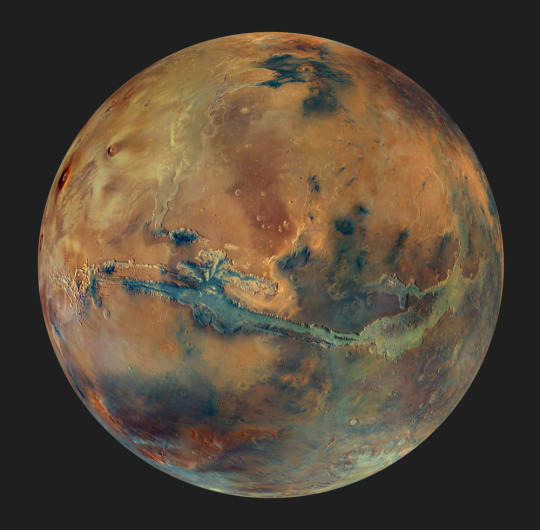
Valles Marineris on Mars in Color © ESA
#mars#solar system#astrophotography#space#planet#universe#galaxy#planets#stars#night sky#astronomy#nebula#cosmos#nasa#esa
3K notes
·
View notes
Text

Mars, as seen by ESA's Mars Express satellite
#go for queue deploy#esa#european space agency#mars#solar system#planet#satellite#space#outer space#space exploration#spaceflight#science#space and astronomy#astronomy#space photography#technology#engineering#stem#exploration#mars express#mars exploration#esa mars express
1K notes
·
View notes
Text

Utopia Planitia on Mars l ESA
608 notes
·
View notes
Text
If the difference between staying on Earth and leaving for the moon or Mars is that you won't get off-world kombucha, then scientists are working to assuage your fear.
Not only might some of the microbes that help ferment kombucha survive in harsh conditions outside Earth's atmosphere, but scientists also speculate the organisms could provide future space-dwellers on Mars or the moon with far more than a tasty beverage. These bacteria might help astronauts create the oxygen they need to breathe.
"Due to their ability to produce oxygen and function as bio-factories, this biotechnology could significantly enhance future space missions and human space exploration efforts," Nicol Caplin, an astrobiologist at the European Space Agency (ESA), said in a statement.
Continue Reading
81 notes
·
View notes
Text
Terra Sabaea and Arabia Terra – ESA Mars Express

One of my all-time favourite images of Mars is this enhanced colour image captured by ESA's Mars Express orbiter on 17 June 2019. It shows a beautiful slice of the Red Planet stretching from the north polar cap to the northern rim of Hellas Planitia, highlighting the crater surface of Terra Sabaea and Arabia Terra. The original image has a resolution of about 1 km/pixel.
To the north, two craters stand out to me: Lyot (a complex crater in Vastitas Borealis) and Moreux (a smaller but visually darker crater in a geologically complex region of Arabia Terra). Near the centre of frame are a pair of large but shallow craters: Cassini and Tikhonravov. To the south lies Huygens, the largest crater on Mars with a well defined rim.
About the mission
Mars Express was launched from the Baikonur Cosmodrome on 2 June 2003 and entered into orbit around Mars in record time on 25 December 2003. It's the second longest lasting Mars orbiter in history after NASA's 2001 Mars Odyssey orbiter.
Due to its flexibility and importance in the study of Mars, the mission has been repeatedly extended to as far out as 2026, with a further provisional extension to 2028 likely. It's hard to believe that this was the same orbiter that deployed the failed Beagle 2 lander to the Martian surface almost 20 years ago.

16 notes
·
View notes
Text
ahhh my college entrance exams week ..... truly an unforgettable experience (my little brother was hospitalized, the exam questions were a joke that still gets repeated to this day and i got cancelled on twitter)
#well cancelled is a strong word but people did complain about me (i didnt even have twitter)#and i remember right after i saw the tweets i went onto an exam that talked abt twitter cancellations. surrealist experience#la pregunta de escribir una redaccion de lengua creo que fue. era ''qué es para Ud. ser patriota'' (flipa)#y fue un drama porque la gente no sabía qué significaba Ud. HSKFJSKFJSKS..........#y esa fue una de varias en fin#mar's midnight rambles#segundo bach no volvería por nada del mundo 🫶
11 notes
·
View notes
Text
Mars memes I made because Curiosity birthday time
Long post, be warned



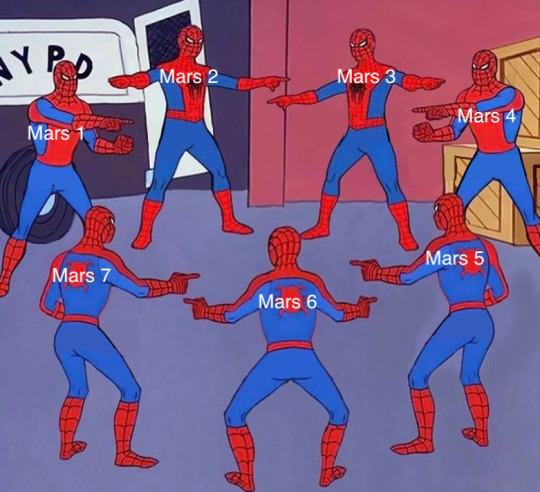




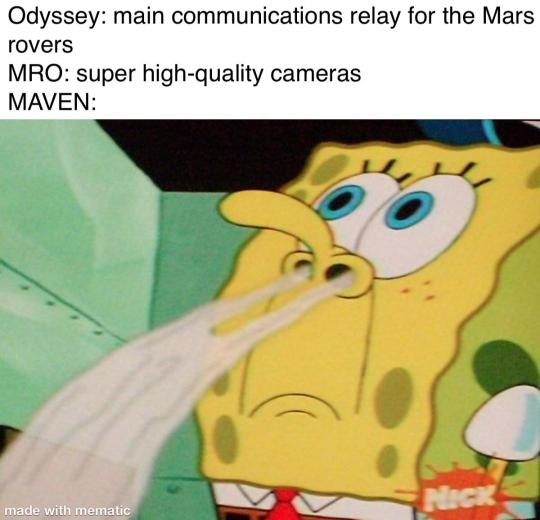
(I know Ody isn't really a "main" relay anymore but I made this a while ago)


26 notes
·
View notes
Text

autism be damned my sim can make a choripán
#ARGENTINA MENTION!!!🔥🔥🔥🔥🔥#tmb mencionan el asado lol cuando agregaron esto?#si estoy jugando a los sims 4 coping mechanisms y toda esa bola#mars plays stuff
11 notes
·
View notes
Text
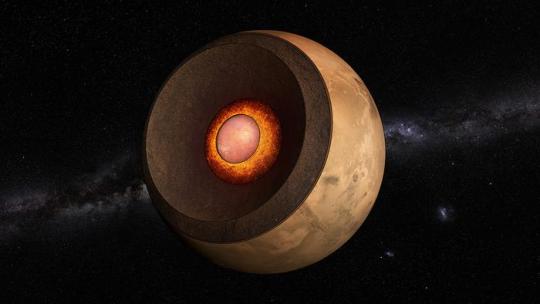
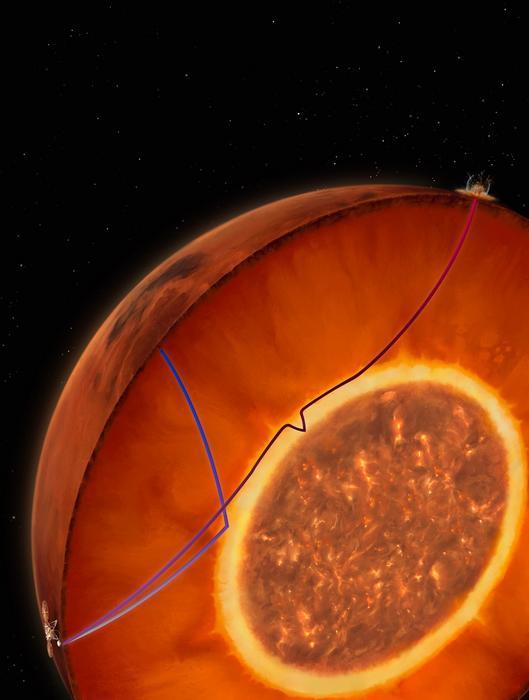
Scientists discover molten layer covering Martian core
NASA’s InSight mission to Mars helped scientists map out Mars’ internal structure, including the size and composition of its core, and provided general hints about its tumultuous formation.
But findings from a new paper published in the journal Nature could lead to reanalysis of that data. An international team of researchers discovered the presence of a molten silicate layer overlying Mars’ metallic core—providing new insights into how Mars formed, evolved and became the barren planet it is today.
Published on October 25, 2023, the team’s paper details the use of seismic data to locate and identify a thin layer of molten silicates (rock-forming minerals that make up the crust and mantle of Mars and Earth) lying between the Martian mantle and core. With the discovery of this molten layer, the researchers determined that Mars’ core is both denser and smaller than previous estimates, a conclusion that better aligns with other geophysical data and analysis of Martian meteorites.
Vedran Lekic, a professor of geology at the University of Maryland and co-author of the paper, compared the molten layer to a ‘heating blanket’ covering the Martian core.
“The blanket not only insulates the heat coming from the core and prevents the core from cooling, but also concentrates radioactive elements whose decay generates heat” Lekic said. “And when that happens, the core is likely to be unable to produce the convective motions that would create a magnetic field—which can explain why Mars currently doesn’t have an active magnetic field around it.”
Without a functional protective magnetic field around itself, a terrestrial planet such as Mars would be extremely vulnerable to harsh solar winds and lose all the water on its surface, making it incapable of sustaining life. Lekic added that this difference between Earth and Mars could be attributed to differences in internal structure and the different planetary evolution paths the two planets took.
“The thermal blanketing of Mars’ metallic core by the liquid layer at the base of the mantle implies that external sources are necessary to generate the magnetic field recorded in the Martian crust during the first 500 to 800 million years of its evolution,” said the paper’s lead author Henri Samuel, a scientist with the French National Center for Scientific Research. “These sources could be energetic impacts or core motion generated by gravitational interactions with ancient satellites which have since then disappeared.”
The team’s conclusions support theories that Mars was at one time a molten ocean of magma that later crystallized to produce a layer of silicate melt enriched in iron and radioactive elements at the base of the Martian mantle. The heat emanating from the radioactive elements would then have dramatically altered the thermal evolution and cooling history of the red planet.
“These layers, if widespread, can have pretty big consequences for the rest of the planet,” Lekic said. “Their existence can help tell us whether magnetic fields can be generated and maintained, how planets cool over time, and also how the dynamics of their interiors change over time.”
NASA’s InSight mission officially ended in December 2022 after more than four years of collecting data on Mars, but the analysis of the observations continues. Samuel, Lekic and their co-authors are among the latest researchers to reexamine prior models of Mars using seismology to confirm the planet’s structure and turbulent history.
"This new discovery of a molten layer is just one example of how we continue to learn new things from the completed InSight mission,” Lekic said. “We hope that the information we’ve gathered on planetary evolution using seismic data is paving the way for future missions to celestial bodies like the moon and other planets like Venus.”
TOP IMAGE....Analysis of Martian seismic data recorded by the InSight mission in combination with first-principles simulations of the seismic properties of liquid metal alloys have revealed that Mars’s liquid iron core is surrounded by a 150-km thick molten silicate layer, as a consequence of which its core is smaller than previously proposed. The decrease in core radius implies a higher density than estimated earlier and is compatible with a metal core consisting of 9–15 wt% of light elements, chiefly S, C, O, and H. CREDIT ©2023 Creative Commons Attribution-NonCommercial-ShareAlike 4.0 International (CC BY-NC-SA 4.0) - Thibaut Roger - NCCR PlanetS - ETH Zurich.
LOWER IMAGE....Artist's view of the internal structure of Mars showing the propagation of diffracted waves from the September 2021 meteorite impact to the SEIS seismometer of the InSight mission. Their trajectory passes through the lower, completely molten part of the silicate layer at the base of the mantle, where seismic velocities are low. CREDIT IPGP / CNES / N. Starter
9 notes
·
View notes
Photo

Martian winter wonderland
Credit: ESA/DLR/FU Berlin, CC BY-SA 3.0 IGO
#art#photography#winter#Mars#wonderland#landscape#scenery#esa#dlr#cosmos#cosmic#universe#mars wallpaper#cosmos wallpaper
27 notes
·
View notes
Text
what if i cried


20 notes
·
View notes
Text
Canals on Mars: A Cosmic Confusion
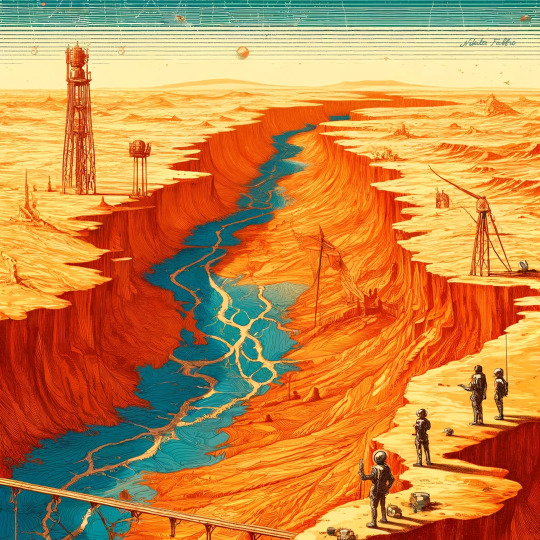
The Martian canals, a saga of interplanetary misinterpretation and steadfast belief, begins with an innocent Italian word "canali," which simply meant "channels." However, when Giovanni Schiaparelli's astronomical observations crossed linguistic borders, "canali" was mistakenly translated into English as "canals," suggesting alien engineering marvels where none existed. Enter Percival Lowell, an astronomer who, enamored by the romantic notion of a Martian civilization, dedicated his career to mapping these nonexistent waterways. Lowell's enthusiasm for Martian canals was so intense that he brushed off any skepticism with the endearing zeal of a man who'd rather find alien engineers than mere erosion on Mars. Indeed, who would prefer a barren, toxic, frigid, radioactive, dusty world for a neighbor?
Interestingly, amidst the fervor over Martian canals and the possibility of extraterrestrial neighbors, there was a curious episode involving the French Academy of Sciences. In 1900, the academy established the Prix Guzman, a prize intended to reward any individual who made contact with a heavenly body. The prize explicitly excluded Mars as a target for this cosmic communication. Mars was considered "too simple" or perhaps too likely a candidate for such contact.


The reality of Mars is a stark departure from Lowell's imaginative vision. The surface of the Red Planet is characterized by an inhospitably frigid climate, with temperatures averaging around -63 degrees Fahrenheit. Its atmosphere, while mostly composed of carbon dioxide, is 100 times thinner than the Earth's—making it utterly unbreathable for humans or other living beings. This means that any unprotected visitor would face immediate death: the low pressure could cause their blood to boil, and without Earth's protective magnetic field, they would be exposed to intense solar and cosmic radiation (and die suffering).
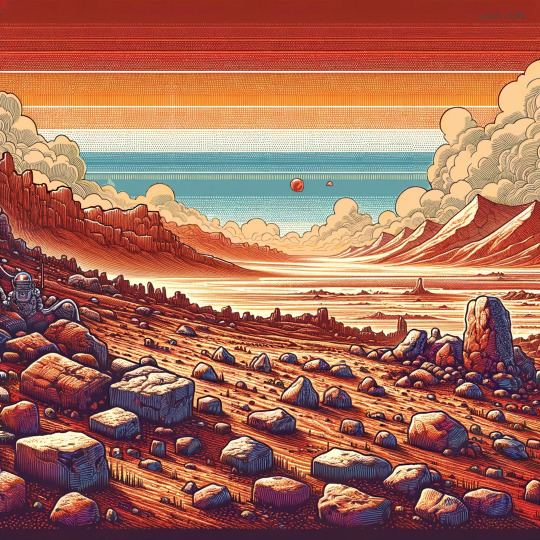
Despite these harsh conditions, scientific consensus and evidence from missions such as NASA's Mars Reconnaissance Orbiter and ESA's Mars Express have confirmed that Mars was once awash with liquid water. Geological features like river valleys and lake beds suggest that billions of years ago, Mars could have supported liquid water on its surface, and possibly life. This evidence of a wetter Mars has reshaped our understanding of the planet and its potential for life.

#mars#space#nasa#esa#science illustration#space history#oddworld#your favorite martian#ai artwork#canals#astronomy#red planet#alien worlds#mars canals#geekyhumor#art#illustrative art#planets#astronomy facts#19th century
2 notes
·
View notes
Video
Perspective view of Mars’s Tharsis volcanoes by European Space Agency
Via Flickr:
This oblique perspective view shows a slice of Mars imaged to mark a milestone for ESA’s Mars Express: its 25 000th orbit around the Red Planet. It was generated from a digital terrain model and the nadir (downward-pointing) and colour channels of Mars Express’s High Resolution Stereo Camera. The vertical scale is exaggerated by a factor of approximately three, making the volcanoes look three times higher than they are in real life. Three of Mars’s famously colossal volcanoes are shown here: from left to right, Arsia, Pavonis and Ascraeus Mons. The mound of Mars’s largest volcano, Olympus Mons, can be spied further away at the top of the frame, while the fractured terrain of Noctis Labyrinthus, Mars’s ‘labyrinth of night’, can be seen in the foreground. Read more [Image description: This image shows a tan-coloured portion of Mars, with the curvature of the planet visible to the top left the frame. Four of Mars’s volcanoes can be seen in relief against the dark background, shown as darker mounds stretching away from the viewer.] Credits: ESA/DLR/FU Berlin, CC BY-SA 3.0 IGO
#ESA#European Space Agency#Space#Universe#Cosmos#Space Science#Science#Space Technology#Tech#Technology#Mars#Dunes#Panorama#Marte#Solar System#Sol#Mars Express#HRSC#High Resolution Stereo Camera#DLR#Red Planet#Exploration#Phobos#Volcano#Arsia Mons#Pavonis Mons#Ascraeus Mons#Olympus Mons#Noctis Labyrinthus#flickr
3 notes
·
View notes
Text
Welcome to the Mars Mission Tournament, pitting Mars spacecraft against each other to determine the Ultimate Martian™
There are 40 missions in the tournament, including flybys, orbiters, landers and rovers (and one helicopter). I have for the most part not included missions which were failures with some exceptions (E.g. Beagle 2, Mars Polar Lander). I'm also splitting up spacecraft within missions in some instances (E.g. Perseverance and Ingenuity, the Viking landers and orbiters).
There is only one unflown mission - the ESA's Rosalind Franklin rover because it's my tournament and I love her!
Stay tuned for a bracket, some thoughts about how it's set up, and introductions to the spacecraft!
#Mars#Mars exploration#mars mission#mars rover#space exploration#nasa#esa#i don't want to like. spam tags but i do want people to see this lol#mars mission tournament
14 notes
·
View notes
Text
Rafael Navarro-Gonzalez (1959-2021): The Mexican Astrobiologist Who Shaped Our Understanding of The Planet Mars

Rafael Navarro-Gonzalez was a talented and internationally recognized chemist and astrobiologist who worked at NASA. Navarro-Gonzalez is known for his work with other researchers to study the planet Mars. He made fundamental contributions to several fields related to Astrobiology, the origin of life, and life in extreme environments. Among his many accomplishments, he helped lead the team that identified ancient organic compounds on Mars. He was a Co-I on the SAM instrument onboard NASA’s Mars Science Laboratory and on the HABIT instrument onboard ESA’s ExoMars mission. He was also on the Curiosity Mars rover team. His research blended laboratory simulations, fieldwork, and theoretical modeling in transdisciplines in chemistry, physics, and biology. This sort of dominance is unusual and requires a dynamic and intellectual curiosity beyond normal boundaries. He identified the role of volcanic lightning in the origin of life on Earth. He has established one of the very best laboratories in Latin-America.
He has published 137 papers, 4 edited books and over 225 abstracts. Among the most significant contributions are those that deal the detection of organics in Mars-like environments from cold (Antarctica), temperate (Atacama) and hot (Mojave and Libya) deserts on Earth.
Navarro-Gonzalez was born in Mexico City on April 25, 1959. He earned a bachelor’s in biology from the National Autonomous University of Mexico (UNAM) where he became full professor in 2002, and a PhD in Chemistry from the University of Maryland at College Park. Dr. Navarro-González established the Laboratory of Plasma Chemistry and Planetary Studies of the Institute of Nuclear Science at UNAM.
Rafael Navarro-Gonzalez was the first recipient of the Molina fellowship award. This prize recognizes outstanding scientific achievement. He was also the recipient of the 2009 Alexander von Humboldt Medal and the World Academy of Sciences Award in Earth Sciences.
He died on Jan. 28, 2021 due to Covid-19-related complications.
In honor of his service, NASA named a mountain on Mars after him. The mountain stretches 450 feet (120 meters) tall, “Rafael Navarro Mountain” is located on Mount Sharp in northwest Gale Crater.

Rafael Navarro Mountain
“Rafael was a good friend and dedicated scientist, and it has been a privilege and honor for our Mars exploration team to work with him over the years" said the principal investigator of Curiosity’s SAM experiment.
“We are truly honored to have a prominent hill named after our dad; it’s his and our dream come true to see this happen,” wrote Navarro-González’s children, Rafael and Karina Navarro Aceves, in a statement to NASA.
“Our dad was an accomplished scientist, but above all, a great human being who managed to balance work and family."
Sources: (x) (x) (x) (x) (x) (x)
#🇲🇽#STEM#Rafael Navarro-Gonzalez#mexican scientists#astronomy#mars#NASA#Mars Science Laboratory#SAM instrument#HABIT instrument#ESA#ExoMars mission#Curiosity mars rover#latin america#volcano#meteorology#antartica#atacama#mojave desert#libya desert#UNAM#National Autonomous University of Mexico#Laboratory of Plasma Chemistry and Planetary Studies#Institute of Nuclear Science#Molina fellowship award#2009 Alexander von Humboldt Medal#World Academy of Sciences Award#covid-19#coronavirus#Rafael Navarro Mountain
4 notes
·
View notes